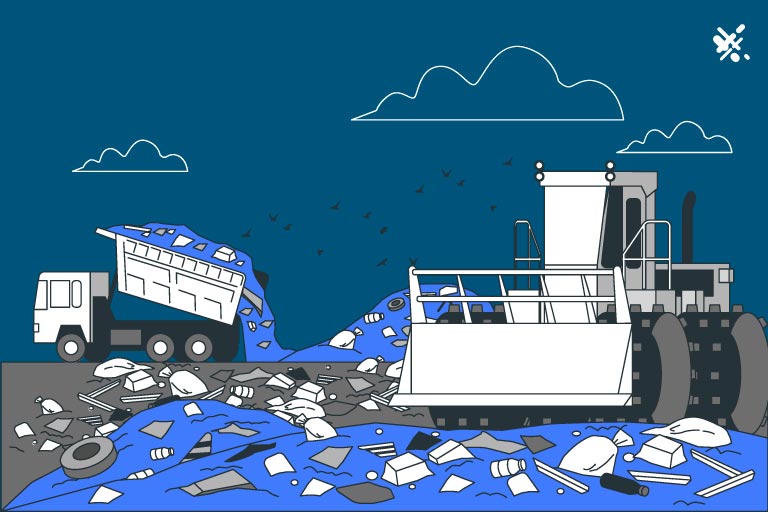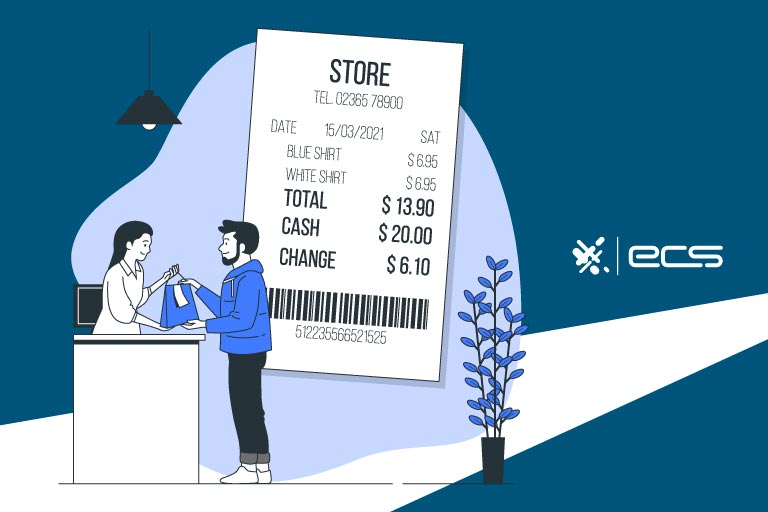In this article, we will explore the advantages and benefits of digital receipts from Dejavoo’s GOGreen and other paperless receipt platforms. Including those for expense reports, business accounts, and the savings that paper receipts ultimately cannot provide for merchants.
Picture yourself hiking up an alpine trail through fragrant cedar and redwood trees. After an invigorating climb, you emerge into a clearing with an incredible view. Green hills studded with evergreens roll out towards the horizon, under perfectly azure skies. A bald eagle flies overhead, pushing this entire opening narrative into a nauseatingly sentimental zone.
But we digress. Return to the guided meditation and think about how many trees are in front of you. Now think about all those trees ripped out of their native soil, silently screaming as they are turned into pulp for paper receipts. Thank you for shopping with us…come again!
Customers Care About Sustainability
To be fair, there are plenty of people who don’t care about eco-friendly business practices, green energy, or reducing your carbon footprint. But there is one group of people who do: your customers. Moreover, even if the environmental aspect is not so compelling (and it may be for some readers), money certainly talks—and printing tons of paper…well, that costs money.
First, let’s talk about your customers—you know…the ones who are always right. Consumers are increasingly motivated by humanitarian and environmental concerns and not just about receipts. A 2020 survey conducted by McKinsey found that as many as 60% of consumers said they would be willing to pay more for a product that had sustainable packaging. And nearly 80% of polled consumers said that the sustainability of a product or brand was an important factor in their decision-making about purchases.
Consumers are becoming increasingly savvy about the supply chain. Some brands are even putting QR codes on products that allow consumers to see where all the ingredients or components came from. And not because they’re curious, but because they want to know that things are sustainably sourced.
Customers Care About Going Green
Even without looking at QR codes and taking a deep dive into the supply chain, consumers are aware enough to know which parts of the product life cycle are the biggest offenders when it comes to sustainability. Or so they think (which is perhaps an assessment for a different article).
One culprit in their eyesight is paper…particularly paper receipts. Around 70% of polled consumers believe that digital receipts are better for the environment. This stat is worth a deep dive. However, because its nuances show some different perceptions of sustainability vis-a-vis paper receipts in different consumer subsets.
Who prefers paper receipts?
- 50% of consumers over the age of 55
- less than 40% of those aged 25-34
- around 30% of consumers aged 16 to 24
These stats show increased care and/or awareness about the environmental impact of paper receipts in younger demographics. Leaving us to picture more mature shoppers complaining that “young people today would give up toilet paper if it meant saving a few trees”. And indeed, this is an angle being peddled to consumers.
Especially by fixture companies that sell bidets. Did you know that a bidet can save 384 trees from becoming your lifetime supply of toilet paper? Or that a roll of toilet paper requires 38 gallons to produce. But a bidet covering the same amount of cleanup uses just an eighth of a gallon?

What Are The Environmental Consequences of Paper Receipt Production?
According to The Huffington Post contributors and their research, one tree makes about 55,0000 receipts. Of course, the number of receipts a given business prints every year will vary widely from business to business. But overall (the same contributors write) receipt production the United States consumes 250 million gallons of oil, 10 million trees, and 1 billion gallons of water.
To put some things in perspective, there are around 228 billion trees in the United States alone. But obviously, receipts are not the only product coming from trees. There are other forms of paper, paper goods, and lumber. Each year around 900 million trees are harvested. And as many as 2.5 billion may be planted, naturally or otherwise—for a net growth of 1.6 billion trees.
You read that right. Even with all those receipts being printed, the total number of trees in the U.S. is increasing, not decreasing. Tangentially, receipt production is a little over 1% of that deforestation. This might lead you to conclude that those silver-haired shoppers are correct in demanding their right to paper receipts.
For those readers who are intrigued by the environmental aspect of receipt production, our cited stats are just one set of data in a sea of ink that is growing itself over the future of this big green and blue ball we live on. For what it’s worth, deforestation might be a bigger problem in third-world countries. Most of it is not for producing paper, but rather for agricultural purposes.
Before setting aside the environmental purview of receipt production, we can conclude two things: (1) it may not really have a net impact on the environment, but (2) consumers definitely think it does. So let’s move on to the next component, the one that really matters—and no, it’s not saving the planet. It’s money.
What is the Cost of Paper Receipts For a Business?
We’re kidding of course…partially. Different causes matter to different people. But one cause that matters to every business owner in a real, tangible way, is profit. Even if you’re not particularly driven by making money (and some business owners start their businesses primarily for financial independence or to pursue a passion), you need to make money in order to keep your business going.
As a business owner, you know that every little thing counts (or at least you should know that, and implement it like you believe it). Each receipt you print may cost between $0.05 and $0.10. While that expense seems fairly negligible, it adds up to more than $312 million for U.S. retailers in total. How much it adds up to for your business will depend on how many receipts your print each day, the quality of the paper, and the ink used (if any, though most receipt printers are thermal these days).
But going with a dime as a nice round number, let’s say you print 100 receipts every day. That’s $10 per day, $3,650 per year, and $304 per month. What if you’re printing five times that number? You’re looking at more than $1,500 per month. And what if your business has several locations? As with anything else, it’s a matter of scale. But no matter how you slice it, you’re eating away at your bottom line.
To put this into some additional perspective, the average credit card interchange fee ranges between 1.4% to 2.6% for Visa and Mastercard. If you own a retail business with an average sale of $10 (say, something like a convenience store) you are chipping 1% off your gross sales in addition to the interchange fees you’re paying to take plastic.
The Cost of Paper for Your Business in General
Tangentially, other paper things cost money as well. If your business is still issuing paper checks, that’s costing you anywhere between $1 to $26, with an average of $6 per check to cover all the backend concerns (such as payroll and accounting). If you’re keeping paper records, that’s also costing you money.
In fact, it may cost you as much as $8,000 per year (if you’re anything like the average business), $8,500 to store all that paper, and $30,000 to manage it. Maybe that’s why paper barons like Xerox are conducting studies to see how paperless services can significantly reduce business expenses.
The same study found that paper workflows are incredibly burdensome. Leading 46% of businesses to admit that paper workflows are time wasters, and 60% of businesses saying that paper workflows significantly impacted their bottom line. Leading 80% of businesses to express a desire for a paperless future.
It’s all very Shakespearian. The company once associated with paper writing about its own demise…or perhaps its rebirth in the venue of digital solutions. In any case, the matter at hand is receipts. Which as we’ve hopefully shown, is one part of a broader framework of paper flow that sucks money out of your business.
That said, you may be wondering about paper marketing material. Studies have shown that paper marketing material goes against the trend here. Resulting in a strong ROI. But that’s a study for another article.
Which Businesses Print the Most Receipts?
The simple answer is the businesses with the highest transaction volumes. Typically, these will be businesses selling goods, not services. And typically, the average sale size of said goods will not be big-ticket items. That said, broadly speaking, the restaurant and retail sectors of the U.S. marketplace are printing tons of receipts. Some estimates even suggest that 300 million receipts are being printed every year by American businesses.

Are Receipts Bad For Your Health?
Let’s return briefly to the environmental impact of printing receipts in terms of toxicity. That’s right…toxic ingredients. Some activists have written extensively about how 93% of receipts are coated with Bisphenol-A (BPA) or Bisphenol-S (BPS) to make the receipts more legible.
We mentioned that in terms of deforestation, receipts are not having a net impact. But there may be something to be said about their environmental impact in terms of disposal since paper receipts cannot be recycled like other forms of paper.
That’s because of the BPA for one—an ingredient you’ve surely heard about since pretty much every plastic item sold to consumers proudly advertises that it’s BPA-free. BPA has been shown (in addition to its pollutant qualities) to cause neurological damage and even fetal damage to unborn (drumroll please) fetuses.
That said, you may wonder if missing paper receipts is doing your customers a disservice. And what about your employees? Treehugger cites research that employees regularly handling paper receipts have 30% more BPA in their bloodstream, which is decidedly…not cool. I mean it is, as defined, toxic to their health.
ESG as a B2B Selling Point
Now the plot thickens, as we bring together the environmental and monetary threads in the form of B2B appeal. We have already established (hopefully) that consumers think digital receipts are better for Mother Earth. But what about other businesses?
Love it or hate it, environmental, social, and governance (ESG) will increasingly be factored into B2B decision-making such as lending. Banks are retooling their underwriting processes to factor in environmental concerns. Sustainable lending increased from $5 billion in 2017 to $120 in 2020, a whopping 2,300% increase in just three years.
It seems hard to believe and will likely spark debate over the degree of its invasiveness, but there may come a day when filling out an application for a business credit card or business loan may involve answering a few questions about certain environmentally-impactful business practices.
Or, there may be an ESG score assigned to your business. Sort of like the credit scores assigned by Experian and Transunion. And if you don’t believe it, firms like Accenture, Moody’s, and Merrill Lynch are already dabbling in ESG scores.
The Benefits of Dejavoo GOGreen
So now we come to the grand finale. What does all this mean for your business? Digital receipts not only reduce the impact on the environment and look better to consumers who are concerned about the world we live in, but they are cost-effective, easier to store, and can be used for reference later. For both merchants and consumers when it comes to accounting and finances.
So, with that said, below are some direct benefits of using Dejovoo’s GOGreen digital receipt platform:
- Save money: No more budgeting for the cost of receipt printers, thermal receipt paper, or ink (if it applies)
- Reduce your carbon footprint: You may (possibly) help the environment. If not through deforestation and water and oil conservation, then perhaps through other factors such as minimizing non-recyclable trash and harmful emissions in the paper-making process.
- Create consumer convenience: Sending digital receipts directly to customer’s cell phones via text message or email will keep everyone organized and streamline the check-out process. You will also appeal to customers, by influencing initial decision-making (customer acquisition) and building brand loyalty (customer retention and reduction of churn)
- Promote healthier shopping experiences: Digital receipts are not only contactless, saving concerns for Covid-19, but they are also free from toxins such as BPA and other harmful chemicals that traditional paper receipts carry.
Your business should consider digital receipts either for a positive impact on the environment, your finances, or even hygienic and toxicity concerns for yourself, your employees, and of course, your customers.
Check, check, check, check, please! But send it to my email. And now, to close off our discussion, here are two other reasons why the future is digital.
Digital Receipts Make Bookkeeping Easier
There’s something satisfying about paper records. It makes one think of warm mahogany shelves stuffed with leather-bound tomes and perhaps a wizened old record keeper who has a bizarre ability to catalog everything by memory. Of course, that’s a complete fantasy. The reality of bookkeeping is more like a shoebox stuffed with disorganized scraps of paper.
Maybe that’s why some estimates suggest that businesses misfile about 20% of their documents and lose about 5% of them entirely. And just like you’d probably expect, government organizations are serious offenders. With the federal government losing around 50 million documents per year. Good enough for government work, as they say.
Digitizing receipts removes the possibility of these types of mistakes entirely. Consider, for instance, a retail business with three registers and six employees working them over the course of the day. As you know (if you manage people) they are often harder to manage and gauge than inventory. You never know if someone is going to be sick, call out sick, show up sick, or just generally be distracted.
Example:
Let’s assume that five employees are on their A-game on a given day, but one employee is a little…distracted. Maybe someone he knows comes to the register. Perhaps someone they happen to be “crushing” on, as the kids say these days. As they lock eyes and stare dreamily into each other’s pupils, your cashier accidentally hands over both copies of the receipt to the customer. What else can you expect? The main concern was scribbling his digits down onto the paper, with a heart encircling the words “text me later.”
In any case, you’ve just lost your paper record, and reconciling the register at the end of the shift is going to be difficult. What if something like that happens several times over the course of the day? Thankfully, most point-of-sale terminals have some digital accounting components. But if these are not integrated into a dashboard that’s easy to consult from a touch screen or one that integrates with your backend accounting software, you’re up receipt creek without a paddle.
Digitizing Receipts Helps Analyze Metrics
In a related vein, digital receipts can be integrated into metrics software that gauges customer transactions—average spend, items purchased, and typical pairings, to name a few. Then, of course, there is also transaction volume by day and hour. These are all factors you can use to improve your bottom line.
For instance, if you know that a certain item is being purchased most often on a Tuesday, you can respond to that by creating displays at the front of the store to either accelerate those purchases on their most popular day. Or perhaps on a different day to balance out the rest of the week.
These metrics from digitized receipts can also be integrated into your inventory management. This can reduce the headache of trying to figure out what to order and when. And in conjunction with the metrics of analyzing customer behavior, it can save you a significant amount of money. They can also be integrated with expense reports, reducing the amount of time you (or someone you pay) spend on accounting and reconciling receipts, purchases, and inventory.

A Final Word On Going Green
Digital Receipts are the way of the future for good reason. They can integrate with other vital functionalities, improve record keeping, build customer loyalty, win new customers, save trees, and keep BPAs out of the bloodstream. Then, of course, there is the fact that reducing your paper trail means more paper, in the form of increased cash flow.
If you’re interested in Dejavoo’s GOGreen Program or alternative digital receipt platform options, please contact ECS, where one of our knowledgeable representatives can get you the information you need to be a part of a better future.
To contact sales, click HERE. And to learn more about ECS Payment Processing visit Contactless & Mobile Payments.
